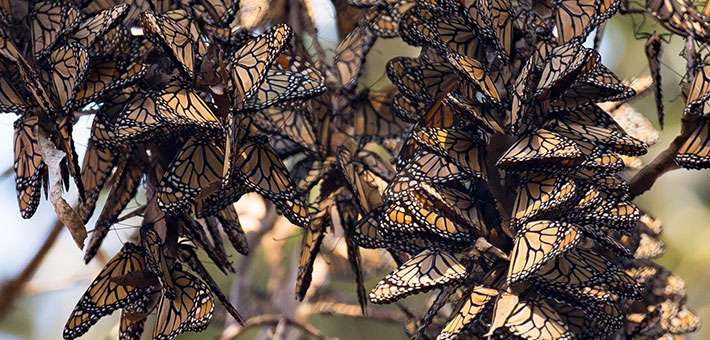
Clusters of overwintering butterflies in California. Photo by Lisa Hupp/USFWS
March 7, 2018 - By Jack Rice - It has been said that the beat of a butterfly's wings in Brazil can cause a tornado in Texas. This phenomenon, known in chaos theory as the "butterfly effect," suggests a small change now can significantly alter the future. Perhaps this idea might also apply to conservation.

(Left) Jack Rice, senior counsel for the California Farm Bureau Federation
After two decades of declining populations, environmental groups filed a petition in 2014 to protect the monarch butterfly under the Endangered Species Act. Perhaps just as predictably, production agriculture is a primary target of that petition.
In June 2019, the U.S. Fish and Wildlife Service will decide whether to list the monarch. But this isn't just another listing: The monarch raises unique issues that fundamentally challenge how we accomplish conservation in the U.S.
The monarch has a remarkable, multigenerational, migratory life cycle, depending solely on milkweed to reproduce and small forested areas to overwinter. Monarchs east of the Rocky Mountains migrate from as far north as Canada to winter in a small, forested area not far from Mexico City. West of the Rockies, monarchs from Washington to Arizona migrate to nearly 400 sites along the California coast to spend the winter.
After literally hanging in trees all winter, monarchs migrate north in the spring. Along the way, four generations of monarchs reproduce, spreading across the U.S. and expanding the population until fall, when the cycle is repeated.
The monarchs' vast summer range, spanning much of the continental U.S., needs forage—flowers—and breeding habitat—milkweed—at just the right locations. In contrast, the monarchs' comparatively tiny overwintering habitat is measured in acres and may be susceptible to the slightest impact.
Though far from conclusive, the available science indicates impacts to the three key factors of winter habitat, flowers and milkweed are contributing to the monarchs' decline.
So, what's different about the monarch? Why isn't the monarch—alongside spotted owls, delta smelt, steelhead, salmon, etc.— just one more species to justify endless lawsuits, studies and grants?
The situation now is different. This is a different time, and the monarch is a different species—and these differences may provide an opportunity to find a new approach to conservation.
This is a different time because people on all sides of the issue think differently about conservation. For decades, conservation has been a conflict industry. The goal has been to undo whatever humans had done by using every coercive regulatory tool available. The organizations involved in these battles may have thrived, but the species have not.
The spotted owl is an example of how this approach fails both species and people. After three decades of conflict, the spotted owl is worse off, and so are many rural communities. The owl isn't at risk from logging, but from the barred owl—a closely related native species—and from fires burning poorly managed forests.
Because of these and similar failures, many conservationists and resource managers are thinking differently about how to help species.
Instead of focusing on how to attack, some conservationists now look for ways to collaborate. Instead of focusing on how to defend, some farmers and ranchers are thinking about how to actively aid species recovery. The monarch presents an opportunity from both perspectives, to see just how much active and collaborative conservation can achieve.
The monarch is a very different species than the owl and smelt, and thereby presents different obstacles and opportunities. Lawyers, biologists and bureaucrats have spent countless hours analyzing and arguing about spotted owls and delta smelt, but few people have actually seen either.
But the monarch lives everywhere and is familiar to nearly everyone. Schoolchildren across the country have spent countless hours watching monarch metamorphosis in their classrooms. It's a friendly and familiar creature you can help in your own backyard, not a distant creature known only to experts.
The monarch's extraordinary life cycle also raises unique issues. It appears that the best way to help monarchs is to ensure there are flowers and milkweed disbursed throughout their migration path. There are no ancient trees to protect or water pumps to regulate—merely a need to encourage patches of flowers and milkweed. This can be solved, but only by working with people, not against them.
Therein lies the opportunity. Farmers and ranchers recognize the threat posed by a possible monarch listing and seek to take an active role. Conservationists recognize that trying to use force isn't likely to help the monarch, and consequently want to work collaboratively.
I started with the idea of the "butterfly effect," because it suggests that slight changes now could result in significant changes later. Perhaps by approaching monarch conservation differently now, we can fundamentally change conservation in the future. Instead of the conflict and coercion that has shaped environmental policy for the past four decades, we can envision conservation based on collaboration and mutual benefit.
The California Farm Bureau Federation is putting this idea to work. We are coordinating with county Farm Bureaus, farmers, ranchers and conservation groups to develop a proactive monarch strategy for California. Our goal is to help the monarch and keep it from being listed under the ESA.
If you can help with habitat or ideas, please contact me at jrice@cfbf.com.
(Jack Rice is senior counsel for the California Farm Bureau Federation.)
Reprinted with permission: California Farm Bureau Federation








